"Old 100th" or "Old Hundredth" is a hymn tune in long metre, from second edition of the Genevan Psalter. It is one of the best known melodies in many occidental Christian musical traditions. The tune is usually attributed to the French composer Louis Bourgeois.

"Herzliebster Jesu" is a Lutheran Passion hymn in German, written in 1630 by Johann Heermann, in 15 stanzas of 4 lines, first published in Devoti Musica Cordis in Breslau. As the original headline reveals, it is based on Augustine of Hippo; this means the seventh chapter of the so-called "Meditationes Divi Augustini", presently ascribed to John of Fécamp.
"Wär Gott nicht mit uns diese Zeit" is a Lutheran hymn, with words written by Martin Luther based on the Psalm 124. The hymn in three stanzas of seven lines each was first published in 1524. It was translated to English and has appeared in 20 hymnals. The hymn formed the base of several compositions, including chorale cantatas by Buxtehude and Bach.
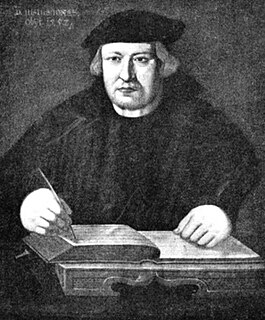
"Wo Gott der Herr nicht bei uns hält" is a Lutheran hymn by Justus Jonas, a paraphrase of Psalm 124 in eight stanzas. It was first published in 1524 in the Erfurt Enchiridion. The theme of the psalm is the need of help against raging enemies. It has been translated also as "Where the Lord God does not stand (stay) with us", "If God the Lord is not with us", "If God the Lord is not on our side", among others.

"Komm, Heiliger Geist, Herre Gott" is a Lutheran hymn for Pentecost, with words written by Martin Luther based on "Veni Sancte Spiritus, reple tuorum corda fidelium". The hymn in three stanzas was first published in 1524. For centuries the chorale has been the prominent hymn (Hauptlied) for Pentecost in German-speaking Lutheranism. Johann Sebastian Bach used it in several chorale preludes, cantatas and his motet Der Geist hilft unser Schwachheit auf, BWV 226.
"Vater unser im Himmelreich" is a Lutheran hymn in German by Martin Luther. He wrote the paraphrase of the Lord's Prayer in 1538, corresponding to his explanation of the prayer in his Kleiner Katechismus. He dedicated one stanza to each of the seven petitions and framed it with an opening and a closing stanza, each stanza in six lines. Luther revised the text several times, as extant manuscript show, concerned to clarify and improve it. He chose and possibly adapted an older anonymous melody, which was possibly associated with secular text, after he had first selected a different one. Other hymn versions of the Lord's Prayer from the 16th and 20th-century have adopted the same tune, known as "Vater unser" and "Old 112th".

"O Welt, sieh hier dein Leben" is a Lutheran Passion hymn in German by Paul Gerhardt. In 16 stanzas of 6 lines, it was first published in 1647 in Johann Crüger's Praxis pietatis melica. The hymn is known as the source for chorales in Bach's Passions. It was translated to English in several versions, for example "O, World! behold upon the tree" by Catherine Winkworth in 1858.
"Herzlich lieb hab ich dich, o Herr" is a Lutheran hymn in German by the Protestant theologian and reformer Martin Schalling, written in Amberg in 1569 and first printed in 1571. It is sung to an anonymous melody, Zahn No. 8326, which appeared in a tablature book for organ in 1577. The hymn is often used for funerals, especially the third and last stanza, "Ach Herr, laß dein lieb Engelein". It appears in the current German Protestant hymnal Evangelisches Gesangbuch (EG).
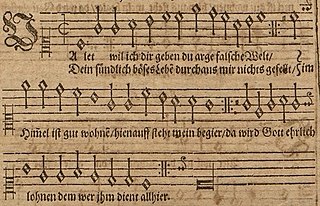
"Valet will ich dir geben" is a Lutheran hymn written by Valerius Herberger in 1613. It is a Sterbelied. The text was published with two hymn tunes by Melchior Teschner, Zahn Nos. 5403 and 5404a, in 1615. The second of these melodies was used in compositions such as chorale preludes by Johann Sebastian Bach and Max Reger. Bach used single stanzas in vocal works, including his St John Passion.
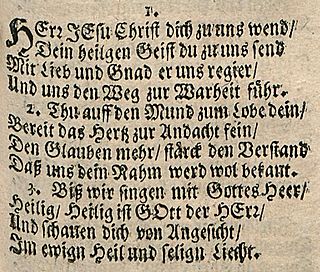
"Herr Jesu Christ, dich zu uns wend" is a Lutheran hymn from the 17th century. Its hymn tune, Zahn No. 624, was adopted in several compositions. It was translated into English and is part of modern hymnals.

"Schmücke dich, o liebe Seele" is a Lutheran hymn in German, with lyrics by Johann Franck and a hymn tune by Johann Crüger. It was first published in Crüger's 1649 Geistliche Kirchen-Melodien, and was later adopted in other hymnals, such as the 1653 edition of his Praxis pietatis melica.
"Herr Jesu Christ, du höchstes Gut" is the beginning of two Lutheran hymns. One is a penitential hymn, written in 1588 by Bartholomäus Ringwaldt, who possibly also created the melody. The other is an anonymous communion hymn, probably based on the former, which appeared first in 1713. Johann Sebastian Bach's used the penitential hymn several times, including the chorale cantata Herr Jesu Christ, du höchstes Gut, BWV 113, based on the hymn.

"Was mein Gott will, das g'scheh allzeit" is a Lutheran hymn in German. The text from c. 1550 is attributed to Albert, Duke of Prussia. The melody, Zahn No. 7568, goes back to a tune by Claudin de Sermisy, written in 1529 for a secular French song. The hymn has belonged to core Lutheran hymnody without interruption and is part of the Protestant hymnal Evangelisches Gesangbuch as EG 364.
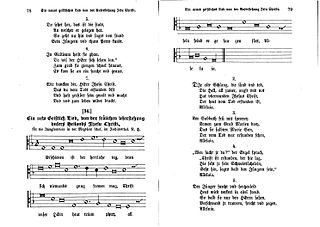
"Erschienen ist der herrlich Tag" is a German Easter hymn, with text and tune written by Nikolaus Herman and published in 1561. It has inspired musical settings by composers from the 17th to the 20th century. It appears in several hymnals, including the German Protestant hymnal Evangelisches Gesangbuch. Other hymns, especially Easter hymns, in both German and English, are sung to the same melody.

"Christus, der uns selig macht" is a German Lutheran Passion hymn in eight stanzas in German by Michael Weiße, written in 1531 as a translation of the Latin hymn "Patris Sapientia" to an older melody of the Bohemian Brethren.
"Auf meinen lieben Gott" is a Lutheran hymn from the 17th century. Several hymns are sung to the same hymn tune, including "Wo soll ich fliehen hin", and it was set in compositions. The hymn was translated into English as "In God, My Faithful God". It is part of modern hymnals and songbooks.
"Wie soll ich dich empfangen" is a Christian hymn for Advent by Paul Gerhardt. It was first published in 1653 in the fifth edition of the hymnal Praxis Pietatis Melica by Johann Crüger, who also created a melody. Johann Sebastian Bach used it as a chorale in his Christmas Oratorio, but with a different melody. Catherine Winkworth translated five of its ten stanzas.
"Nun liebe Seel, nun ist es Zeit", alternatively written "Nun, liebe Seel, nun ist es Zeit", is a Lutheran hymn for Epiphany, in five stanzas of six lines each, by Georg Weissel. It was first printed in 1642, set as a motet by Johannes Eccard. A version with an additional stanza is attributed to Johann Christoph Arnschwanger.
"Aus der Tiefen rufe ich, Herr, zu dir" is a German hymn with a text by Georg Christoph Schwämmlein. The opening lines of the hymn stay close to those of Psalm 130, while most stanzas of the hymn are written from a Christian perspective. It was first published, with its own hymn tune, in the Nürnberg hymnal of 1676. Gottfried Vopelius published it with a new hymn tune in the 1682 Neu Leipziger Gesangbuch, p. 936. From 1699 to 1738 the hymn was published with four more new melodies.
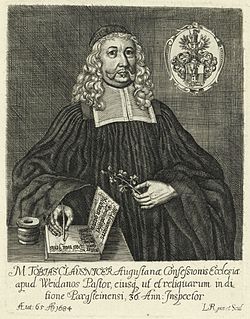
"Liebster Jesu, wir sind hier" is a Lutheran hymn with text written by Tobias Clausnitzer in 1663, and a hymn tune, Zahn No. 3498b, based on a 1664 melody by Johann Rudolph Ahle. A prayer for illumination, it is suitable for the opening of a church service and to be sung before a sermon. The song is part of the Protestant hymnal Evangelisches Gesangbuch as EG 161. It is also part of the Catholic hymnal Gotteslob as GL 149. It is popular also in English translations such as "Blessed Jesus, at your word" by Catherine Winkworth.













